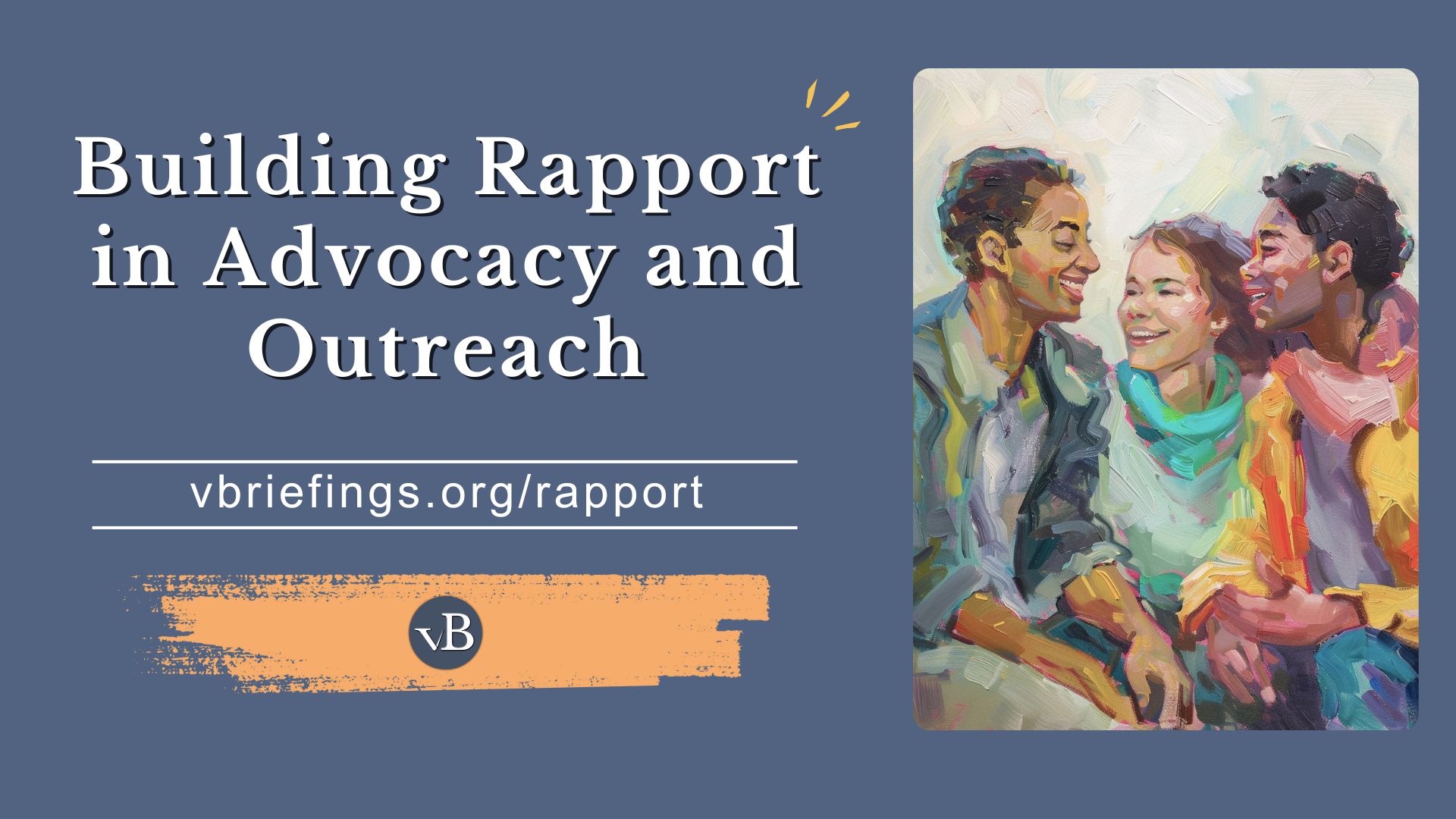Preface
Briefing description and more.
This briefing shows how rapport building is especially important for animal rights and vegan advocacy and why it helps. It provides specific techniques to build rapport and discusses how it applies in various settings.
Companion Videos
How to use companion videos
Videos may be posted on multiple social media platforms, and you can share them on each platform according each platform’s conventions.
Share this Briefing
Social Media Sharing Image
This image will be used when sharing the briefing on a social media platform. You can see all social sharing images in the grid view.

How to share this briefing
Click on the icon for the platform on which you wish to share. What happens next depends on the platform, but generally a popup will appear, letting you add your own text as you share.
Briefing Meta
Metrics
Note: we will publish additional briefings after completing flashcards and presentation slides for selected briefings.
Counts:
| Main Text | |
| Key Points | 4 |
| Counterclaims | 1 |
| Supplementary | 4 |
| Further Study | 3 |
| Footnotes | 20 |
| Media & Advocacy | |
| Advocacy Notes | 1 |
| —Socratic Questions | 0 |
| Flashcards | 49 |
| Presentation Slides | 0 |
| Memes & Infographics | 0 |
| Companion Videos | 0 |
Other Meta:
Date Posted:
Last Edited:
Edit Log:
Key Points Links
Loading…
Help Us Improve
Please send your suggestions for improvements, or report any issues with this briefing to team@vbriefings.org
We appreciate that you are taking the time to help up improve. All suggestions and reports will be carefully considered.
Summary
A concise summary of the briefing (see below for citations).
Building rapport is crucial in animal rights and vegan advocacy to foster trust and create open, persuasive communication. Techniques like active listening, empathy, finding common ground, and humor can adapt to different settings, such as outreach or debates, making rapport a strategic tool for persuasion and effective advocacy.
Context
Places this topic in its larger context.
Attitudes toward veganism and animal ethics are deeply intertwined with personal, cultural, and ethical dimensions, making conversations around them potentially challenging.
Building rapport is a fundamental aspect of the art of persuasion because it establishes a connection and trust between the communicator and the audience, which is essential for influencing attitudes and behaviors.
By building rapport, activists can more effectively communicate their message, foster understanding and compassion, and inspire the kind of deep, personal change that leads to a more humane and ethical world.
Key Points
This section provides talking points.
Building rapport is especially important in animal rights and vegan advocacy.
Building rapport is especially important in animal rights and vegan advocacy because these conversations challenge deeply ingrained cultural practices and personal habits, creating natural defensiveness that can only be overcome through genuine connection based on mutual respect and understanding.
Navigating Emotional Sensitivities. Discussions about animal rights and veganism can be highly emotional. They often touch on issues related to ethics, personal identity, and deeply held beliefs. Building rapport creates a safe space for these conversations, allowing individuals to express their thoughts and feelings without fear of ridicule or attack. This empathetic approach can lead to more productive and meaningful discussions.
Overcoming Preconceptions. Many people have preconceived notions about animal rights and veganism, often viewing them through stereotypes or negative experiences. Building rapport helps activists overcome these barriers by establishing a connection based on understanding and respect, rather than judgment and confrontation. When people feel understood, they’re more likely to be open-minded and receptive to new information.
Creating Personal Relevance. For many, the plight of animals or the decision to go vegan seems distant or unrelated to their daily lives. Building rapport allows activists to personalize the message, connecting the broader issues to the individual’s values, experiences, and concerns. When people see how these issues relate directly to them and their values, they’re more likely to care and consider changing their behavior.
Encouraging Openness to Change. Change is hard, especially when it involves altering deeply ingrained habits and beliefs. Rapport helps ease the defensive resistance that often accompanies discussions about change. When people feel that the activist genuinely cares about them and respects their autonomy, they’re more likely to explore new ideas and consider making changes.
Fostering Long-Term Engagement. Animal rights and vegan activism often aim not just for short-term awareness but for long-term commitment and lifestyle changes. Building rapport lays the foundation for ongoing relationships and dialogue. It’s about creating allies and a community, not just winning an argument. These relationships can provide support and encouragement that are crucial for sustaining long-term commitment.
Addressing Complex and Diverse Perspectives. People come from a wide range of cultural, economic, and personal backgrounds, each with its own view on animal rights and veganism. Rapport allows activists to approach these diverse perspectives with sensitivity and adapt their message accordingly. Understanding where someone is coming from helps in crafting a more relevant and compelling argument.
Promoting Positive Representation. Activists often face the challenge of negative stereotypes. By building rapport and engaging in respectful, constructive conversations, activists can counter these stereotypes and demonstrate that the movement is about compassion, respect, and rational discourse. This positive representation can attract more people to the cause.
There are reasons building rapport helps.
Building rapport helps because it creates a foundation of trust and connection that reduces resistance, opens communication channels, and increases receptivity to new ideas, making people more likely to consider perspectives that might otherwise be dismissed.
Creates a Trusting Environment. When you build rapport, you create a sense of trust and safety. People are more likely to be open to your ideas and consider your perspective when they feel you understand them and have their interests at heart. Trust is the foundation of any persuasive effort; without it, your words may be met with skepticism or outright resistance.
Facilitates Open Communication. Rapport opens lines of communication. When people feel connected to you, they’re more likely to listen actively and engage in the conversation. This two-way communication is vital for persuasion because it allows you to understand their concerns and tailor your message accordingly.
Reduces Resistance. People naturally resist being changed or told what to do. However, if they feel a personal connection with you, their defensive barriers are lowered. Rapport makes individuals more receptive to your message because they see you as an ally rather than an adversary.
Increases Influence. When you have a good rapport with someone, they’re more likely to trust your judgment and expertise. This trust increases your ability to influence their decisions and actions. They’re more likely to take your suggestions seriously and consider your viewpoint because they believe you have their best interests in mind.
Enhances Emotional Connection. Persuasion is not just a logical process; it’s also an emotional one. Building rapport helps you connect with others on an emotional level. People are often more influenced by their emotions than by logical arguments alone. By establishing an emotional connection, you can more effectively appeal to their values, desires, and fears.
Facilitates Adaptability. When you have a strong rapport, you’re better able to read the other person and adapt your message on the fly. You can sense when to push forward and when to back off, which arguments are working, and which aren’t. This adaptability is crucial in persuasion, as a one-size-fits-all approach rarely works.
Encourages Reciprocity. When people feel you’ve taken the time to understand them and respect their views, they’re more likely to return the favor by listening to and considering your perspective. This mutual exchange is at the heart of effective persuasion.
The approach to building rapport varies depending on the setting.
Building rapport is essential in any form of communication, especially when discussing sensitive topics like animal rights and veganism. The approach to building rapport varies significantly depending on the setting, whether it’s street outreach, giving talks, conversing with family and friends, or engaging in formal debates.
Street Outreach
- Street outreach is often brief and with strangers, so you have a brief window to make a positive impression. Clarity, brevity, and immediate engagement are crucial.
- When engaging in street outreach, the key is to start by understanding where the other person is coming from. Active and empathetic listening is crucial. People are more likely to engage in a conversation if they feel heard and understood.
- Finding common ground, even on simple things like caring for pets or enjoying certain foods, establishes a connection and makes further dialogue easier. Your body language is also important; maintaining a friendly posture and respecting personal space makes the interaction more comfortable.
Giving Talks
- Giving talks requires a slightly different approach. Beginning with personal anecdotes or stories that resonate with your audience can create an emotional connection and make your message more memorable.
- Encouraging questions and including interactive elements actively engage the audience, making the experience more personal and less like a lecture.
- Using visuals and humor can also make your talk more enjoyable and relatable.
- Talks are more structured and less personal; you’re addressing a group, so the focus is on engaging and maintaining the attention of the audience as a whole.
Informal Conversations
- Conversing with family and friends is more personal and emotional. Using your shared history and experiences can help. Remind them of your mutual respect and care for each other.
- These conversations can be emotional, so patience and understanding are vital.
- Avoid judgmental language and emphasize that you respect them, even if you don’t agree with or respect their choices.
Formal Debates
- In formal debates, even if you disagree, showing respect promotes thoughtful engagement rather than hostility.
- Presenting your arguments clearly and calmly is essential, as getting too emotional can undermine your credibility and rapport with the audience.
- Acknowledging valid points from your opponent shows you’re listening and engaging with their arguments, not just reciting your own.
- Debates are structured and formal, focusing on the strength and clarity of your arguments rather than personal connection.
- Rapport is built through professional respect and the quality of your discourse.
In all these situations, building rapport is about making a genuine connection and understanding the other person’s perspective, even if you don’t agree with it. It’s about finding common ground and communicating respectfully and effectively. Each setting requires a slightly different approach, but the core principles of empathy, respect, and clear communication are universal.
Specific techniques can be used to build rapport.
Using Socratic-Style Questioning
Incorporating Socratic questioning—a method that uses thoughtful, focused, open-ended inquiries to guide self-discovery—can further enhance this process by helping people examine their assumptions, explore alternative perspectives, and reach their own insights.
Socratic questioning shows your interest in their perspective and encourages a deeper conversation. Such questions facilitate a more engaging and meaningful dialogue, essential for building rapport.
Rather than imposing your viewpoint, Socratic questioning creates a spirit of respectful curiosity where the other person is treated as the expert in their own experience.
This approach not only builds trust but also empowers others to engage in critical thinking about their beliefs in a non-threatening environment.
Note: All the briefings on vbriefings.org provide Socratic-style questions in the advocacy resource section, except for those briefings where it wouldn’t make sense—such as this briefing and others in the Advocacy Section.
Active Listening
Active listening involves fully concentrating on what is being said rather than just passively hearing the message of the speaker. It includes giving feedback through positive reinforcement, summarizing, and paraphrasing to show understanding.
Rogers and Farson (1957) emphasized the importance of active listening in creating a supportive and open communication environment.1
Mirroring and Matching
Mirroring and matching are techniques where you subtly mimic the body language, speech patterns, or attitudes of the person you’re communicating with. This can create a sense of empathy and understanding.
Chartrand and Bargh (1999) found that mimicking someone’s behavior can increase their liking for you, which is a key component of rapport.2
Showing Empathy
Showing empathy involves understanding and sharing the feelings of another. It’s about genuinely caring for the other person’s experiences and emotions. Empathy is a powerful tool for building deep, lasting connections.
According to Decety and Jackson (2004), empathy facilitates pro-social behavior and is essential in positive social interactions.3
Use Shared Interests and Experiences
Finding common ground by identifying shared interests or experiences can significantly enhance rapport. This technique creates a sense of unity and understanding. Cialdini (2001) discusses the principle of liking, where people are more likely to be influenced by others who they perceive as similar to themselves.4
Using Positive Body Language
Using positive body language, such as maintaining eye contact, nodding, and smiling, can make you appear more approachable and engaged. Nonverbal cues play a crucial role in communication and can significantly impact the perception of empathy and understanding.5
Using Self-Disclosure
Sharing personal stories or information about yourself can make you seem more human and relatable, fostering a deeper connection. Collins and Miller (1994) found that “people who engage in intimate disclosures tend to be liked more than those who disclose at lower levels.”6
Providing Validation
Validating someone’s feelings or opinions where you can shows respect for them.
This technique can defuse potential conflict and encourage open dialogue.
Humor
Appropriately used humor can break down barriers and create a more relaxed and friendly environment. However, it’s important to use humor sensitively and appropriately, considering the setting and the individual’s preferences. Martin (2007) notes that humor can be a powerful tool for building relationships and enhancing rapport.7
Counterclaims
Responses to some yes but retorts.
Claim: You must be brutally blunt. Later, they will reflect and get it.
Some believe that even if people are offended at the time of your interaction, they will later reflect and come to understand your position.
That heightened emotions, even negative ones, can lead to more serious consideration and reflection later is a complex and somewhat controversial topic in the realm of psychology and communication studies.
While a blunt approach might work for some individuals in some settings, it’s not universally effective and can often be counterproductive. A more nuanced, empathetic, and respectful approach will be more effective in the long run, fostering open dialogue, deeper reflection, and lasting change.
Here’s what science has to say about this:
- Emotional Arousal and Memory. Research has shown that emotional arousal can enhance memory. Emotionally charged events are often remembered better than neutral events.8 This might suggest that if an outreach encounter is emotionally charged, it could be more memorable. However, this doesn’t necessarily mean the person will reflect positively on the message; they might remember the negative interaction more than the content itself.
- Cognitive Dissonance. Cognitive dissonance theory suggests that people have a powerful drive to maintain internal consistency.9 When confronted with information that creates dissonance, they might change their attitudes or beliefs to reduce discomfort. However, if the approach is too aggressive, people might resolve dissonance by rejecting the new information outright, especially if it threatens their self-image or core beliefs.
- Backfire Effect. The backfire effect occurs when attempts to correct misinformation end up reinforcing or amplifying the misperceptions within the targeted group.10 If an outreach approach is too confrontational or blunt, it might cause individuals to become defensive and even more firmly rooted in their original beliefs, counteracting the activist’s intentions.
- Elaboration Likelihood Model (ELM). The ELM suggests that there are two primary paths to persuasion: the central route, which involves careful and thoughtful consideration of the arguments, and the peripheral route, which relies on superficial cues.11 While strong emotions might engage someone more deeply and invoke the central route, they can also lead to a reliance on peripheral cues (like the negative emotions associated with the interaction) rather than the actual argument.
- Moral Outrage. Some research suggests that moral outrage, while a powerful motivator for action, might not always be effective in persuasion, especially if it leads to social polarization.12 If the target of the outreach feels attacked or judged, they might become less open to the message.
- Message Delivery. How a message is delivered matters. Studies in communication suggest that people are more receptive to persuasive attempts that are seen as credible and that come from someone they trust or view positively.13 A confrontational approach might undermine the perceived credibility and trustworthiness of the messenger.
Supplementary Info
Additional information that may prove useful.
Additional Scientific Support for Building Rapport
- Rapport is rooted in social psychology. It involves aspects like mutual attention, shared positivity, and coordination in conversation. These elements create a sense of connection and trust, which are crucial for effective persuasion.14
- Building rapport establishes trust, making the audience more receptive to the message. A study by McCroskey and Young (1981) found that speakers who are perceived as trustworthy are more likely to be persuasive.15
- Rapport ensures that the audience is more open and attentive. According to Dr. Robert Cialdini, a leading expert in influence, rapport makes people more susceptible to persuasion techniques.16
- Resistance to persuasion is a common challenge. Rapport can lower psychological barriers, making individuals more open to considering new viewpoints. A study by Hovland, Janis, and Kelley (1953) highlights the importance of the communicator’s personality in overcoming resistance.17
Further Study
Sources providing a deeper understanding of the topic or related topics.
Other Resources
This 2-minute video discusses 4 principles for building rapport.18
The book “How to Make People Like You…” is a practical guide offering techniques to quickly establish rapport through body language, voice tone, and conversation skills.19
Cialdini’s updated classic book on the psychology of persuasion includes principles that can be applied to building rapport and relationships.20
Advocacy Resources
Information to help with outreach and advocacy.
Note: we will publish additional briefings after completing flashcards and presentation slides for selected briefings.
Share This Briefing
Cloned from the Preface Section on page load.
Companion Videos
Cloned from the Preface Section on page load.
Memes and Infographics
No images found.
How to use Memes and Infographics
To sequence through all memes and infographics on this page, click on any image than use the arrow keys or the arrow buttons to show next and previous images.
To share a meme or infographic, right click on the image and choose download or save as. Then upload the image to the platform of choice.
Presentation Slides
Slides not available.
How to Use the Presentation Slides
You can view the slideshow full screen by clicking on the first link above.
To use Canva presenter mode, view the speaker notes, or download the slides as PowerPoint, login to Canva (the free account works) and follow the Full Canva Link provided above.
To copy this presentation to your own Canva project, use the Full Canva Link provided above, then select File->Make a Copy from the upper left. You can build your own unique presentation from multiple briefings by copying the presentation from each briefing and then building another presentation from the copied presentations.
Flash Cards
We partner with Brainscape because of their excellent features for learning. You will need to create a free Brainscape account to study the cards.
Go to Flash Cards: This will take you to a list of decks.
About Flash Cards and Brainscape
Flash cards are here to help you commit important facts and concepts in this briefing to memory.
In Brainscape, there is one deck for each briefing. You can study more than one deck at a time. Brainscape uses spaced repetition to promote memory retention. It is “the secret to learning more while studying less.”
You can study using your browser, but Brainscape also has a free mobile app that makes learning anywhere easy.
Socratic Questions
Socratic-style questions are embedded in the Advocacy Notes below, and shown in italics.
These are open-ended, thought-provoking questions designed to encourage critical thinking, self-reflection, and deeper understanding. They are inspired by the Socratic method, a teaching technique attributed to the ancient Greek philosopher Socrates, who would ask his students probing questions rather than directly providing answers.
The goal is to help people examine their beliefs, clarify their thoughts, uncover assumptions, and explore the evidence and reasoning behind their ideas.
Advocacy Notes
Tips for Advocacy and Outreach
Briefings in the Advocacy Section of the knowledge base typically don’t offer tips because the entire briefing is about advocacy, and Socratic-style questions wouldn’t make sense here.
Footnotes
Our sources, with links back to where they are used.
- Rogers, Carl. R., and Richard E. Farson. Active Listening. Chicago: Industrial Relations Center, University of Chicago, 1957. ↩︎
- Chartrand, Tanya. L., and John A. Bargh. “The Chameleon Effect: The Perception-Behavior Link and Social Interaction.” Journal of Personality and Social Psychology, vol. 76, no. 6, 199, p. 893. ↩︎
- Decety, Jean., and Philip L. Jackson. “The functional architecture of human empathy.”Behavioral and Cognitive Neuroscience Reviews, vol. 3, no. 2, 2004, pp. 71-100. ↩︎
- Cialdini, Robert. B. Influence: Science and Practice. Boston: Allyn and Bacon, 2001. ↩︎
- Mehrabian, Albert. Nonverbal Communication. Aldine-Atherton, 1972 ↩︎
- Collins, Nancy. L., and Lynn C. Miller. “Self-disclosure and liking: A meta-analytic review.” Psychological Bulletin, vol. 116, no. 3, 1994, p. 457. ↩︎
- Martin, Rod. A. The Psychology of Humor: An Integrative Approach. Burlington, MA: Elsevier Academic Press, 2007. ↩︎
- Kensinger, Elizabeth. A. “Negative emotion enhances memory accuracy: Behavioral and neuroimaging evidence.” Current Directions in Psychological Science, vol. 16, no. 4, 1997, pp. 213-218. ↩︎
- Festinger, Leon. A Theory of Cognitive Dissonance. Stanford University Press, 1957. ↩︎
- Nyhan, Brendan., and Jason Reifler. “When corrections fail: The persistence of political misperceptions.” Political Behavior, vol. 32, no. 2, 2010, pp. 303-330. ↩︎
- Petty, Richard. E., and John T. Cacioppo. “The elaboration likelihood model of persuasion.” Advances in Experimental Social Psychology, vol. 19, 1986, pp. 123-205 ↩︎
- Brady, William. J., et al. “Emotion shapes the diffusion of moralized content in social networks.” Proceedings of the National Academy of Sciences, vol. 114, no. 28, 2017, pp. 7313-7318. ↩︎
- Hovland, Carl. I., and Walter Weiss. “The influence of source credibility on communication effectiveness.” Public Opinion Quarterly, vol. 15, no. 4, 1951, pp. 635-650. ↩︎
- Tickle-Degnen, Linda., and Robert Rosenthal. “The nature of rapport and its nonverbal correlates.
Psychological Inquiry, vol. 1, no. 4, 1990, pp. 285–293. https://doi.org/10.1207/s15327965pli0104_1 ↩︎ - Fisher, Douglas, and Nancy Frey. “Teacher Credibility in Literacy Learning.” Journal of Adolescent & Adult Literacy, vol. 63, no. 3, 2019, pp. 356–59. JSTOR, https://www.jstor.org/stable/48556222. Accessed 15 Mar. 2024. ↩︎
- Cialdini, Robert. “The Science and Practice of Persuasion.” The Cornell Hotel and Restaurant Administration Quarterly, vol. 43, no. 2, Apr. 2002, pp. 40–50. Accessed 16 Jan. 2025. ↩︎
- Hovland, C.I., Irving L. Janis, and Harold H. Kelley. . Communication and Persuasion. Yale University Press, 1953. 20. ↩︎
- AIN Group. “Building Rapport: 4 Principles.” YouTube, 9 Sept. 2019, youtu.be/iY0m8dm3HeA?si=w2L3o6_8-cfokAvG. Accessed 3 July 2024 ↩︎
- Boothman, Nicholas. How to Make People Like You in 90 Seconds or Less. Workman Publishing, 2008. https://www.amazon.com/Make-People-Like-Seconds-Less/dp/B001BAJ2B6/ ↩︎
- Cialdini, Robert B. Influence: The Psychology of Persuasion, New Edition. Harper Business, 2021. https://www.amazon.com/Influence-New-Expanded-Psychology-Persuasion/dp/B08HZ57WYN ↩︎




